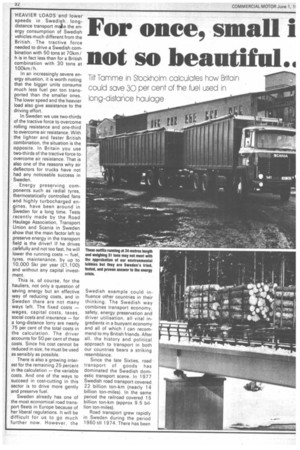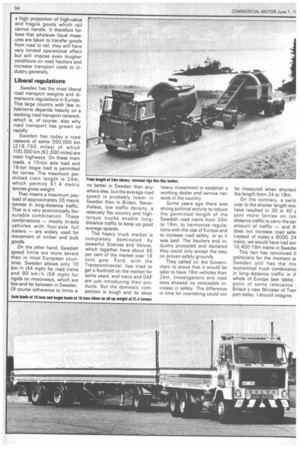For once, small i not so beautiful..
Page 34

Page 35

Page 36

If you've noticed an error in this article please click here to report it so we can fix it.
Tit Tamme in Stockholm calculates how Britain could save 30 per cent of e fuel used in long-distance haulage
HEAVIER LOADS and lower speeds in Swedish longdistance transport me the energy consumption of Swedish vehicles much different from the British. The tractive force needed to drive a Swedish combination with 50 tons at 70km / h is in fact less than for a British combination with 30 tons at 100km/h.
In an increasingly severe energy situation, it is worth noting that the bigger units consume much less fuel per ton transported than the smaller ones. The lower speed and the heavier load also give assistance to the driving effort.
In Sweden we use two-thirds of the tractive force to overcome rolling resistance and one-third to overcome air resistance. With the lighter and faster British combination, the situation is the opposite. In Britain you use two-thirds of the tractive force to overcome air resistance. That is also one of the reasons why air deflectors for trucks have not had any noticeable success in Sweden.
Energy preserving components such as radial tyres, thermostatically controlled fans and highly turbocharged engines, have been around in Sweden for a long time. Tests recently made by the Road Haulage Association, Transport Union and Scania in Sweden show that the main factor left to preserve energy in the transport field is the driver! If he drives carefully and not too fast, he will lower the running costs — fuel, tyres, maintenance, by up to 10,000 Skr per year (E1,100) and without any capital investment.
This is, of course, for the hauliers, not only a question of saving energy but an effective way of reducing costs, and in Sweden there are not many ways left. The fixed costs — wages, capital costs, taxes, social costs and insurance — for a long-distance lorry are nearly 75 per cent of the total costs in the calculation. The driver accounts for 50 per cent of these costs. Since his cost cannot be reduced in size, he must be used as sensibly as possible.
There is also a growing interest for the remaining 25 percent in the calculation — the variable costs. And one of the ways to succeed in cost-cutting in this sector is to drive more gently and preserve fuel,
Sweden already has one of the most economical road trans
port fleets in Europe because of her liberal regulations. It will be difficult for us to go much further now However, the Swedish example could influence other countries in their thinking. The Swedish way combines transport economy, safety, energy preservation and driver utilisation, all vital ingredients in a buoyant economy and all of which I can recommend to my British friends. After all, the history and political approach to transport in both our countries bears a striking resemblance.
Since the late Sixties, road transport of goods has dominated the Swedish domestic transport scene. In 1977 Swedish road transport covered 22 billion ton-km (nearly 14 billion ton-miles). In the same period the railroad covered 15 billion ton-km (approx 9.5 billion ton-miles).
Road transport grew rapidly in Sweden during the period 1960 till 1974. There has been
a slowdown recently and during 1975 and 1976, for the first time since the War, lorry mileage dropped. So also did the rest of the transport sectors, with rail services suffering a heavier decline.
In spite of political obstacles and rapidly growing costs the prognosis on the chart above shows that road transport will increase its share of traffic in Sweden to approximately 35 billion ton-km (nearly 22 billion ton-miles) by 1990, this according to the latest estimates from the Swedish Department oi Communications.
The growth of roadtransported goods has increased most over long distances lately, and this trend is expected tc continue. However, the road transport industry in Sweden it very anxious about a new natio. nal transport policy beinc formed now which will favoui rail even more and put additional cost and tax burdens on roac transport.
The economical situation ir road haulage is very poor. Higlfixed costs, wages, taxes, insu rances and capital costs make i increasingly difficult to earn living in the road haulage busi ness. Small operators and heav, competition make it relativel, hard to maintain rates, althougl the Government keeps its eye oi the price situation with "voluntary— price control syt tern.
Although there is politic pressure to move more good from the road to rail, the oppol /unities are very limited in prac tice. In fact the transport MOVE ments are very local and cannc be moved to rail. Some 89 pt cent are movements of less tha 100 km (63 miles). Only thre per cent of goods transported t road move over distances e: ceeding 300 km (188 miles).
To transfer goods movin less than 300 km to rail is ni practical, so that only the thrE per cent could be affected t law. The three per cent includi
a high proportion of high-value and fragile goods which rail cannot handle. It therefore follows that whatever fiscal meas-ures are taken to transfer goods from road to rail, they will have very limited operational effect. but will impose even tougher conditions on road hauliers and increase transport costs to industry generally.
Liberal regulations
Sweden has the most liberal road transport weights and dimensions regulations in Europe. This large country with few inhabitants depends heavily on a working road transport network, which is, of course, also why road transport has grown so rapidly.
Sweden has today a road network of some 350,000 km (218,750 miles) of which 100,000 km (62,500 miles) are main highways. On these main roads, a 10-ton axle load and 16-ton bogie load is permitted for lorries. The maximum permitted train length is 24m, which permits 51.4 metric tonnes gross weight.
That means a maximum payload of approximately 35 metric tonnes in long-distance traffic, That is a very economically favourable combination. These combinations — mostly tri-axle vehicles with four-axle full trailers — are widely used for movement of timber and bulk goods.
On the other hand, Swedish speed limits are more severe than in most European countries. Sweden allows only 70 km/h (44 mph) for road trains and 90 km/h (56 mph) for rigids on motorways, which are few and far between in Sweden. Of course adherence to limits is no better in Sweden than anywhere else, but the average road speed is probably lower in Sweden than in Britain. Nevertheless, low traffic density, a relatively flat country and hightorque trucks enable longdistance traffic to keep up good average speeds.
The heavy truck market is completely dominated by powerful Scanias and Volvos, which together have about 95 per cent of the market over 16 tons gvw. Ford, with the Transcontinental, has tried to get a foothold on the market for some years; and Iveco and DAF are just introducing their products. But the domestic competition is tough and its takes heavy investment to establish a working dealer and service network in the country.
Some years ago there was strong political activity to reduce the permitted length of the Swedish road trains from 24m to 18m, to harmonize regulations with the rest of Europe and to increase road safety, or so it was said. The hauliers and industry protested and declared they could only accept the step on proven safety grounds.
They called on the Government to prove that it would be safer to have 18m vehicles than 24m. Investigations and road tests showed no noticeable increase in safety. The difference in time for overtaking could not be measured when shorteni the length from 24 to 18m.
On the contrary, a switc over to the shorter length woi. have resulted in 30 or 40 cent more lorries on Ion distance traffic to carry the sar amount of traffic — and th does not increase road safe" Instead of today's 8000 24 trains, we would have had sor 10,400 18m trains in Swede'
This fact has convinced tl politicians for the moment ar Sweden still has the mo economical truck combinatioi in long-distance traffic in tl whole of Europe (see table). point of some relevance Britain's new Minister of Tran port today, I should imagine.












































































































